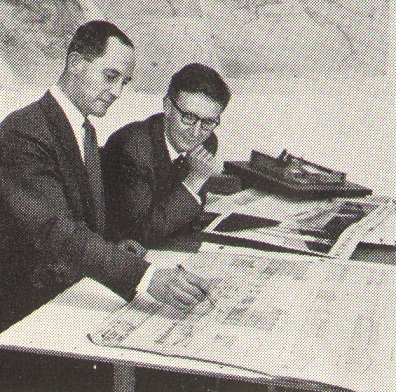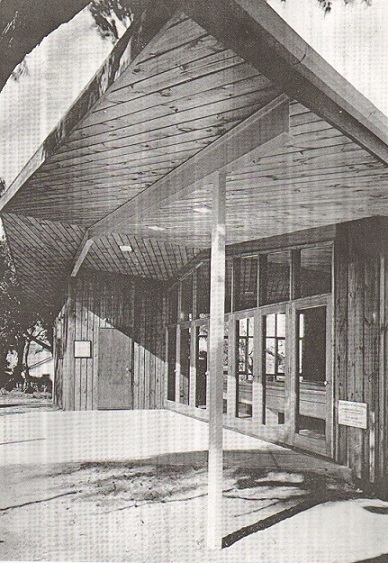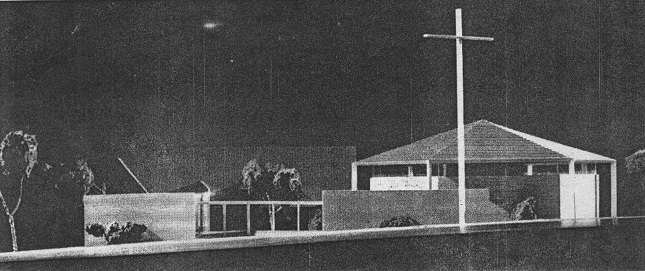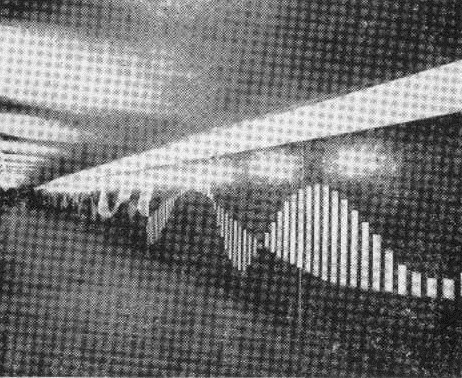Born
in Melbourne on 14 October 1920, Arthur Austen Bunbury was the eldest
son of clerk Austin Edgar Bunbury (1894-1986) and his wife, the former Alice
Etheridge Davis (1896-1966). Completing his secondary education at Carey
Baptist Grammar School, Bunbury enlisted with the Australian Army in
1941 and served with the 2/8th Armoured Regiment before he was
discharged in September 1945 with the rank of Captain.
Bunbury may have been drawn to an architectural career through his cousin, Lester Bunbury (1916-2000), who was already on his way to becoming one of Australia's leading interior and industrial designers. In 1947, Arthur enrolled in the architecture course at Melbourne University under the army's post-war rehabilitation scheme, and spent his first year at the temporary campus in Mildura before transferring to Parkville. While undertaking his studies, Bunbury met fellow undergraduate Mary Thelma Mackay (1928-), and the couple married in January 1950. Mary Bunbury subsequently worked as an architect with Robert S Demaine & Associates (1950-51), Mussen, Mackay & Potter (1951-52) and the Department of Works (early 1953). For the remainder of 1953, Arthur and Mary Bunbury travelled across Australia together, "investigating housing design and building problems associated with climate and materials in the remote parts of the continent".
Returning to Melbourne, Bunbury entered into partnership with architect James Earle (1927-2014) whom he had met at university when both men were undertaking studies in town planning. Earle, who had already gained experience in the offices of Stephenson & Turner, Hassell & McConnell and Muir & Shepherd, had commenced his own architectural practice in 1953, and subsequently invited Bunbury to join him. The partnership of Earle & Bunbury was brief but prolific, and undertook a string of commissions that encapsulated private houses, commercial buildings and, notably, churches and church-related buildings (mostly obtained through Earle's connections with the Methodist church). Mary Bunbury worked part-time for the practice, and was credited as "architect in association" on the design of an Anglican church at Angelsea. During this period, Bunbury fostered an notable association with the Abbey family of Essendon, designing houses for all three brothers (of which two were built) as well as premises for their window blind and awning business, Dural Leeds Pty Ltd.
In early 1960, Bunbury withdrew from partnership with Earle due to the worsening of a medical condition that he had contracted during his time in the Army: Ménière's Disease, a disorder of the inner ear that can affect hearing and balance. Bunbury initially attempted to establish his own practice, along with wife Mary, styled as Arthur Bunbury & Associates. The office completed a number of projects that Bunbury had commenced whilst still associated with Earle. Some of these, namely the Angus Abbey Residence in Strathmore and the Church of St Paul in Kew East, bear the name of Earle & Bunbury on the original working drawings, but, upon completion, were ascribed to Arthur Bunbury & Associates.
Still suffering from his illness, Bunbury withdrew from private architectural practice in 1961 to accept the position of departmental head of the Architecture School at the Maktab Technik (Technical College) in Kuala Lumpur, Malaysia. He and Mary left Australia in early 1962 and remained in Malaysia for three years, during which time she taught architectural history at the same college on a part-time basis. Returning in late 1964, the couple resumed private practice in Melbourne. In 1966, Bunbury took up the position of Staff Architect to the University of Western Australia, which was previously held by Professor Gordon Stephenson. The Bunbury family (by then including five children) relocated to Perth. For a few years, Mary worked alongside her husband as an Assistant Planning Architect before taking up a teaching position in Scotland. She later returned to Perth, working for a private firm before she and Arthur separated in 1971.
Bunbury, meanwhile, continued to serve as Staff Architect to the University of WA. In 1970, the university had engaged noted landscape designer Jean Verschuer to advise on changes to pedestrian and vehicle movements resulting from the construction of a new underpass. She was later appointed as the inaugural University Landscape Architect and, working in the Office of the University Architect, collaborated closely with Bunbury on the transformation of the campus. This culminated in the 1975 campus masterplan that, among other things, recommended that car-parking be limited to a maximum of 10% of the campus area, with key open spaces, such as the Oak Lawn and Riley Oval, retained. Verschuer remarried in 1978 (becoming Lady Jean Brodie-Hall) and retired from her university post in 1981. Bunbury himself retired four years later, and was succeeded as University Architect by leading Perth practitioner Gus Ferguson. Bunbury died five years later, on 24 October 1990.
Bunbury may have been drawn to an architectural career through his cousin, Lester Bunbury (1916-2000), who was already on his way to becoming one of Australia's leading interior and industrial designers. In 1947, Arthur enrolled in the architecture course at Melbourne University under the army's post-war rehabilitation scheme, and spent his first year at the temporary campus in Mildura before transferring to Parkville. While undertaking his studies, Bunbury met fellow undergraduate Mary Thelma Mackay (1928-), and the couple married in January 1950. Mary Bunbury subsequently worked as an architect with Robert S Demaine & Associates (1950-51), Mussen, Mackay & Potter (1951-52) and the Department of Works (early 1953). For the remainder of 1953, Arthur and Mary Bunbury travelled across Australia together, "investigating housing design and building problems associated with climate and materials in the remote parts of the continent".
Returning to Melbourne, Bunbury entered into partnership with architect James Earle (1927-2014) whom he had met at university when both men were undertaking studies in town planning. Earle, who had already gained experience in the offices of Stephenson & Turner, Hassell & McConnell and Muir & Shepherd, had commenced his own architectural practice in 1953, and subsequently invited Bunbury to join him. The partnership of Earle & Bunbury was brief but prolific, and undertook a string of commissions that encapsulated private houses, commercial buildings and, notably, churches and church-related buildings (mostly obtained through Earle's connections with the Methodist church). Mary Bunbury worked part-time for the practice, and was credited as "architect in association" on the design of an Anglican church at Angelsea. During this period, Bunbury fostered an notable association with the Abbey family of Essendon, designing houses for all three brothers (of which two were built) as well as premises for their window blind and awning business, Dural Leeds Pty Ltd.
In early 1960, Bunbury withdrew from partnership with Earle due to the worsening of a medical condition that he had contracted during his time in the Army: Ménière's Disease, a disorder of the inner ear that can affect hearing and balance. Bunbury initially attempted to establish his own practice, along with wife Mary, styled as Arthur Bunbury & Associates. The office completed a number of projects that Bunbury had commenced whilst still associated with Earle. Some of these, namely the Angus Abbey Residence in Strathmore and the Church of St Paul in Kew East, bear the name of Earle & Bunbury on the original working drawings, but, upon completion, were ascribed to Arthur Bunbury & Associates.
Still suffering from his illness, Bunbury withdrew from private architectural practice in 1961 to accept the position of departmental head of the Architecture School at the Maktab Technik (Technical College) in Kuala Lumpur, Malaysia. He and Mary left Australia in early 1962 and remained in Malaysia for three years, during which time she taught architectural history at the same college on a part-time basis. Returning in late 1964, the couple resumed private practice in Melbourne. In 1966, Bunbury took up the position of Staff Architect to the University of Western Australia, which was previously held by Professor Gordon Stephenson. The Bunbury family (by then including five children) relocated to Perth. For a few years, Mary worked alongside her husband as an Assistant Planning Architect before taking up a teaching position in Scotland. She later returned to Perth, working for a private firm before she and Arthur separated in 1971.
Bunbury, meanwhile, continued to serve as Staff Architect to the University of WA. In 1970, the university had engaged noted landscape designer Jean Verschuer to advise on changes to pedestrian and vehicle movements resulting from the construction of a new underpass. She was later appointed as the inaugural University Landscape Architect and, working in the Office of the University Architect, collaborated closely with Bunbury on the transformation of the campus. This culminated in the 1975 campus masterplan that, among other things, recommended that car-parking be limited to a maximum of 10% of the campus area, with key open spaces, such as the Oak Lawn and Riley Oval, retained. Verschuer remarried in 1978 (becoming Lady Jean Brodie-Hall) and retired from her university post in 1981. Bunbury himself retired four years later, and was succeeded as University Architect by leading Perth practitioner Gus Ferguson. Bunbury died five years later, on 24 October 1990.
Select List of Projects
Earle & Bunbury [listing only those buildings for which Bunbury was Project Architect]
| 1955 1956 1957 1958 1959 1960 | Additional chillers at Hamilton Abattoirs, Hamilton Residence, Moonga Road, Kooyoung [demolished] Abattoirs, Camperdown Church of the Transfiguration, Angelsea [Mary Bunbury, associate architect] Residence for W C Abbey, Wickham Grove, Strathmore Residence for A H R (Royce) Abbey [sketch design only; not built] Factory for Dural Leeds Pty Ltd, Roberts Road, Niddrie Factory for Dural Leeds Pty Ltd, Ascot Vale Car showroom for B Stillwell, 142 Cotham Road, Kew |
Arthur Bunbury & Associates
| 1961 | Residence for A M Abbey, 33 Bournian Avenue, Strathmore St Paul's Church of England, Windella Avenue, Kew East |
Staff Architect, University of WA
| 1970 1975 | Pedestrian tunnel under Winthrop Avenue Campus masterplan (with Jean Verschuer) |
 | |
| Portrait of Arthur Bunbury (left) with James Earle |
 | |
| Church of the Transfiguration, Angelsea (1957) |
 | |
| Angus Abbey Residence, Strathmore (1959-61) |
 | |
| St Paul's Church of England, Kew East (1960-61) |
 | |
| Pedestrian underpass, University of WA, Perth (1970) |
| Acknowledgements Special thanks to the late Jim Earle for sharing memories and documentation. Biographical information on Mary Bunbury is partly drawn from Julie Willis's Ph D thesis, "Women in Architecture in Victoria, 1905-1955" (1997) |
